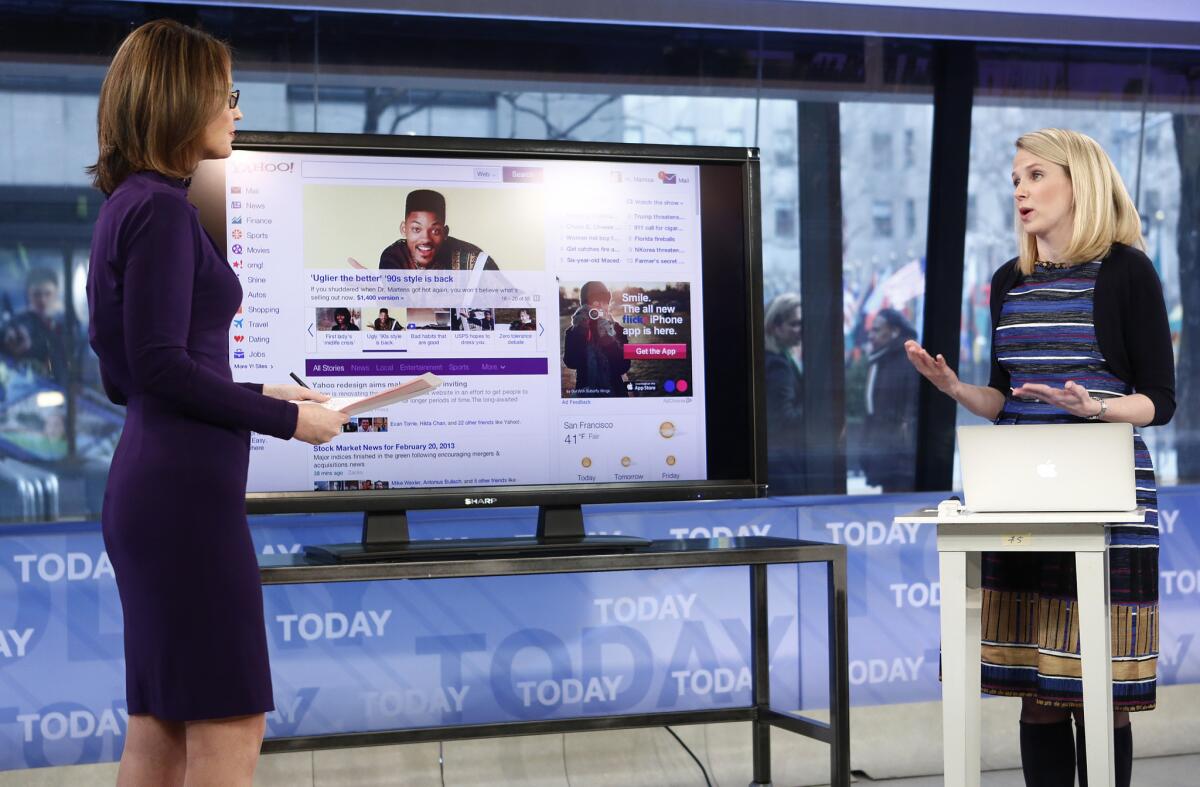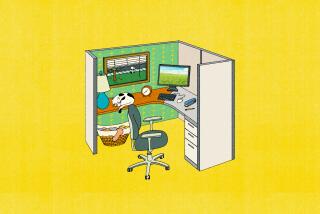Memo to Yahoo: the office is overrated

- Share via
When the first modern office buildings sprung up in America at the end of the 19th century, it was an unquestioned expectation that employees would show up for work there every day. Like the factory workers who came before them, office workers usually clocked in and out, and they sat at their desks — most arranged in highly regimented rows — from morning until early evening, under constant supervision. Even trips to the water cooler were often monitored.
With the development of computers and more advanced telecommunications in the 1970s, some employees began to imagine a day when it might be possible to work from home, free from oversight and more in control of their work day. Today, working from home is becoming so common that the idea of making every employee come into the office five days a week seems almost tyrannical. In many quarters, the old factory model offices are becoming a distant memory.
It was for this reason that the Yahoo memo leaked last week banning telecommuting and corralling workers back into the office was treated with bafflement and derision. Human resources director Jackie Reses explained that Yahoo was now explicitly against the idea of working from home, arguing that it’s generally better to do work in an office setting. “Some of the best decisions and insights come from hallway and cafeteria discussions, meeting new people, and impromptu team meetings,” Reses wrote in the memo. “Being a Yahoo isn’t just about your day-to-day job, it is about the interactions and experiences that are only possible in our offices.”
Reses’ thinking distills what has practically become an axiom of workplace design: that good work comes out of collaboration and the unplanned results of serendipitous encounters. The core idea is that productivity and creativity increase when a company subtly coerces workers into running into one another in corridors, stairways, informal meeting rooms and lunch areas — all places where they are encouraged to continue talking shop. Workers who randomly run into one another combust into flames of innovation, producing ideas that — were they silently working behind closed doors or, worse, at home — they otherwise wouldn’t.
Or so the thinking goes.
But, unsurprisingly, spontaneous workplace encounters aren’t easy to force into being. One example from the late 1980s is the former Scandinavian Airlines building in Stockholm, which became a model for progressive offices the world over. The architect, Niels Torp, designed it with a central main “street” lined with shops, and a central cafe where it was envisioned workers would congregate and informally brainstorm new directions for the company.
The result? Just 9% of interactions took place on the artificial street or in the cafe. The vast majority of productive meetings continued to take place in private offices, where it was possible to keep conversation and attention focused.
Rather than obsessing over serendipitous encounters, workplaces should be more concerned with the variety of work that people do all day, only some of which calls for an office setting.
A more promising, and expansive, model of work, popular in northern Europe, is called “activity-based working.” The employee chooses the best place for the work that he or she needs to do that day.
Based on research showing that workers in the typical traditional office rarely spend more than a third of their day at their desks, activity-based working encourages the genuine mobility and autonomy that modern information technology such as email and video conferencing affords, while also handily decreasing the costs of maintaining expensive office space (though the initial investment in creating an accommodating environment is much higher).
In contemporary workplaces in the Netherlands, such as those at the insurance company Interpolis and the Amsterdam offices of Microsoft, workers don’t have their own desks. Instead, they can choose from a variety of spaces — a private office, a semi-open informal meeting space or a cafe. Because most of the workers spend at least one to two days a week working from home, there’s never a scramble for space. Employees can choose to collaborate or not, and many informal meetings can take place off-site.
Even the Dutch central government is taking steps to make its work more time- and place-independent, allowing some of it to be done at home. Studies of some of these workplaces suggest an increase in internal communication and ad hoc encounters. Staff have positive evaluations of their own productivity. And, in fact, it can become easier to reach people. The reason isn’t hard to fathom: Workplaces that aren’t so dependent on executive or managerial oversight can make for more cooperation among workers themselves.
A number of tech companies in Silicon Valley, Facebook among them, have adopted versions of these flexible policies — albeit often leaving it to managers to decide whether and when employees can take advantage of them.
According to Yahoo employees who spoke anonymously to the New York Times, the new ban represents an attempt to re-energize morale in what is widely seen as a Silicon Valley has-been. But rather than forcing everyone to come in, a more daring and energizing move might be to give everyone more autonomy. Workplaces function best when they’re controlled by workers themselves and not underwritten by coercion and threats from managers with fixed ideas.
As Yahoo tries to return to being at the progressive edge of Silicon Valley, it might consider adopting more progressive — and ultimately more productive — work policies, ones that allow its employees freedom to choose how and where they work their best.
Nikil Saval is an editor of n+1 and the author of a forthcoming book about the history and future of the office.
More to Read
A cure for the common opinion
Get thought-provoking perspectives with our weekly newsletter.
You may occasionally receive promotional content from the Los Angeles Times.










